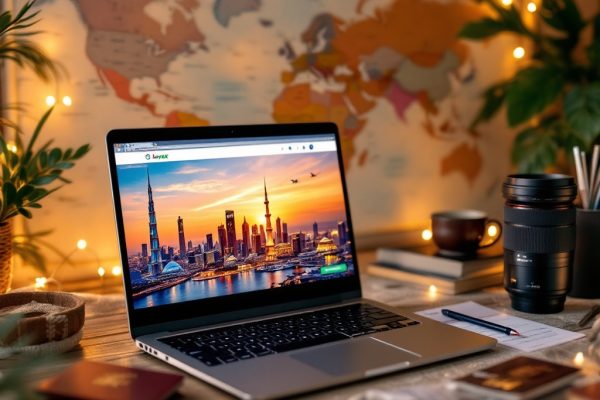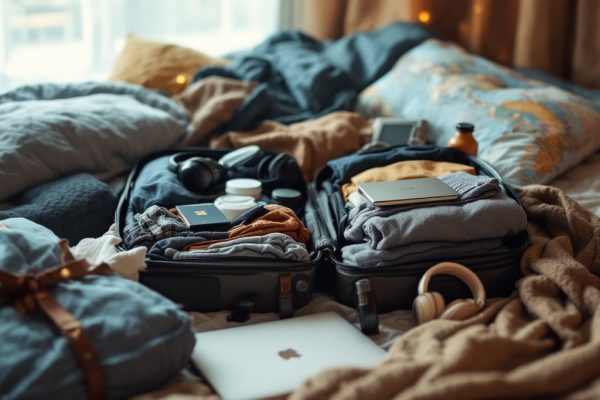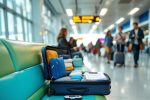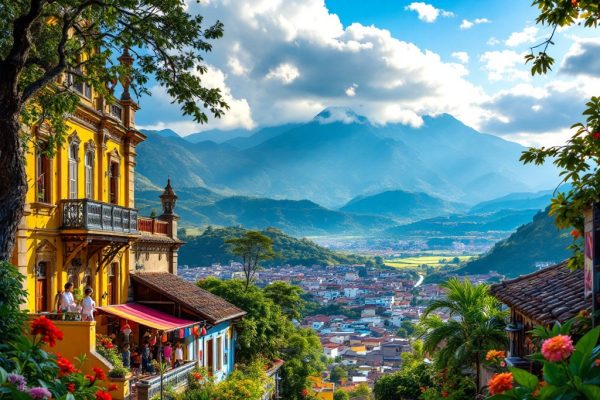What You Need to Know Before You Go: Tips for Traveling to Australia for the First Time
Dreaming of Australia? From the Sydney Opera House to the Great Barrier Reef, your adventure awaits! This guide covers essential trip planning, including visa requirements (like the ETA), packing tips for diverse climates, and safety advice for unique wildlife encounters. Learn about local customs, transportation options, and budgeting to maximize your experience. Start planning your unforgettable Australian journey today!
Important information
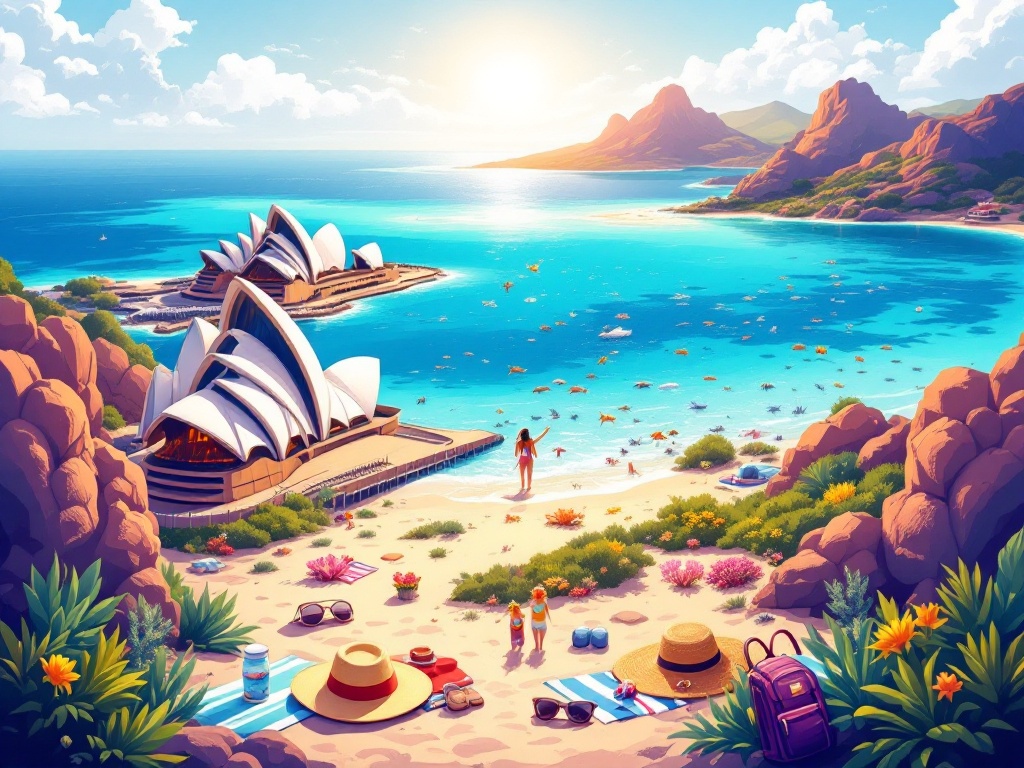
- Obtain the correct visa based on your nationality and travel purpose. An ETA is often suitable for tourists.
- Pack versatile clothing for varied climates, including swimwear, comfortable shoes, and warm layers. Sun protection (high-SPF sunscreen, hat, sunglasses) is vital.
- Australia has strict biosecurity laws. Declare all food, plant, and animal products on arrival to avoid penalties.
- Australia is vast. Long distances often necessitate domestic flights. Consider travel times when planning.
- Swim between the red and yellow flags on beaches for safety. These areas are patrolled by lifeguards.
Planning Your First Trip to Australia
Planning your Australian Adventure:Visa and Insurance: Begin by checking visa requirements. The Electronic Travel Authority (ETA) is a common choice for tourists. Travel insurance is highly recommended for peace of mind.Packing Essentials: Australia’s climate ranges from tropical to temperate, making packing a challenge. Pack light clothing, swimwear, and comfortable walking shoes. Don’t forget warmer layers for cooler evenings or regions. Sun protection is essential.
Local Customs and Safety
While Australian customs are generally straightforward, learning a few basic greetings is a thoughtful gesture. Understanding tipping practices is also beneficial.
Wildlife and Belongings
Australia has unique wildlife. Familiarize yourself with safety guidelines, especially around animals and water activities. Protect your belongings by avoiding displays of valuables. Learn local emergency procedures and contact numbers for added safety.
Step 1: Research and Visa
Research visa requirements and apply for the appropriate visa based on your nationality and purpose of visit. The ETA is a popular option for eligible tourists.
Step 2: Secure Travel Insurance
Obtain comprehensive travel insurance to cover unexpected medical expenses, trip cancellations, lost luggage, and other unforeseen events.
Step 3: Pack Smart
Pack versatile clothing suitable for diverse climates, including swimwear, comfortable walking shoes, and warmer layers. Don’t forget essential sun protection items.
Step 4: Learn Basic Customs
Familiarize yourself with basic Australian customs and etiquette. Learning a few greetings and understanding tipping practices can enhance your experience.
Step 5: Prioritize Safety
Research safety guidelines related to wildlife encounters and water activities. Take precautions to protect your belongings and learn local emergency procedures.
First-timer’s Guide: Essential Tips
Planning your Australian adventure? Here’s a step-by-step guide:
Check visa requirements. Verify the specific visa requirements for your nationality before booking anything.
Secure comprehensive travel insurance. Protect yourself against unforeseen circumstances with a robust travel insurance policy.
Understand local currency and banking. Familiarize yourself with the Australian dollar (AUD) and local banking practices to manage your finances effectively.
Learn basic Aussie slang and etiquette. Enhance your experience by learning some common Australian slang and understanding local customs.
Pack for Australia’s diverse climate. Be prepared for varying weather conditions by packing a variety of clothing, including layers.
Book flights and accommodations in advance. Secure your travel arrangements early, especially during peak season, to avoid disappointment and higher prices.
Notify your bank and phone provider. Inform your bank and phone provider of your travel dates to ensure uninterrupted service.
Photocopy important documents. Make copies of your passport, visa, and other essential documents as a precaution.
Download helpful travel apps. Utilize travel apps for navigation, translation, currency conversion, and other helpful functions.
Bring a universal adapter. Ensure your electronics are compatible with Australian outlets by packing a universal adapter.
Minimize jet lag. Gradually adjust your sleep schedule before departure to reduce the effects of jet lag.
Respect Aboriginal culture. Show respect for Aboriginal culture and traditions during your travels.
Prioritize sun protection. Pack sunscreen, hats, and sunglasses to protect yourself from the strong Australian sun.
Be mindful of wildlife. Be aware of Australia’s unique wildlife and take necessary safety precautions.
Stay hydrated. Drink plenty of water, especially in warmer regions, to avoid dehydration.
Practice water safety. Familiarize yourself with water safety guidelines and always swim between the flags at designated beaches.
Planning Tools: Resources for Organizing Your Trip
Rome2rio helps you plan trips by showing various transportation options.
Sygic Travel creates personalized itineraries and offers offline maps.
TripIt simplifies organization by keeping all your travel plans in one place.
Visa and Entry Requirements
Planning a trip to Australia? You’ll need a valid passport and the correct visa. Your required visa depends on your citizenship and the purpose of your visit. Whether you’re visiting as a tourist, coming for work, or pursuing studies, apply for your visa well in advance as processing times can vary. Consider purchasing travel insurance for a worry-free trip.
Obtaining the Right Visa
Planning a trip to Australia? Most visitors need a visa, so check the requirements based on your nationality. Your visa type depends on your purpose of visit. Tourist visas cover vacations. Business travelers need business visas. Students should apply for student visas. Those seeking a working holiday adventure should explore the dedicated working holiday visa. Apply online via the Australian Department of Home Affairs. Remember that processing times can fluctuate, so apply early. Ensure your passport remains valid for at least six months after your return date.
Check visa requirements. Most visitors to Australia need a visa, so it’s essential to verify the specific requirements based on your nationality.
Choose the right visa type. Your visa type depends on the purpose of your visit: tourist visas for vacations, business visas for business trips, student visas for studies, and working holiday visas for those seeking a working holiday experience.
Apply online. Apply for your visa online through the Australian Department of Home Affairs website.
Apply early. Visa processing times can vary, so it’s recommended to apply well in advance of your intended travel dates.
Check passport validity. Ensure your passport’s validity extends for at least six months beyond your planned return date.
Understanding Entry Requirements
Planning an Australian adventure? Entry requirements depend on your nationality, and you may need a visa. For the most up-to-date information, visit the Australian Department of Home Affairs website to find the specific visa and entry details relevant to your citizenship. While travel is opening up, be sure to check for any lingering COVID-19 restrictions before you depart.
Filling the Passenger Card: Avoiding Visa Issues
Complete your Incoming Passenger Card accurately to avoid potential visa problems. Declare all items you are bringing into the country, including food, plants, and animal products. Inaccurate declarations can lead to serious consequences, such as visa cancellation.
Best Time to Visit Australia
For pleasant temperatures and fewer crowds, spring (September to November) and autumn (March to May) are ideal for exploring most areas.
Summer (December to February) is perfect for beachgoers in southern destinations like Sydney and Melbourne, though expect hotter weather and increased tourism.
Northern regions such as Cairns and Darwin are best experienced during the dry season (May to October) for optimal weather and minimal rainfall.
This period, particularly June to October, also offers prime diving and snorkeling conditions on the Great Barrier Reef.
Seasonal Weather Patterns
Summer (December to February): Hot, dry weather ideal for swimming and outdoor activities.
Autumn (March to May): Mild temperatures and colorful foliage.
Winter (June to August): Outback adventures and skiing in the Snowy Mountains.
Spring (September to November): Wildflowers and active wildlife create a beautiful time to explore.
Events and Festivals to Plan Around
Australia pulsates with exciting events and festivals, offering unforgettable experiences. From May to June, Sydney transforms into a dazzling spectacle of light, music, and innovation during Vivid Sydney. Sports enthusiasts won’t want to miss the Australian Open, a grand slam tennis tournament held in Melbourne each January. July brings NAIDOC Week, a vibrant celebration of Aboriginal and Torres Strait Islander history and culture. To pinpoint specific dates, locations, and discover smaller local festivals, checking local tourism websites is essential. These resources offer detailed information, like Vivid Sydney installation locations and the Australian Open’s schedule, ensuring you can maximize your Australian adventure.
Vivid Sydney
Experience a dazzling spectacle of light, music, and innovation in Sydney from May to June.
Australian Open
A grand slam tennis tournament held in Melbourne each January.
NAIDOC Week
Celebrate Aboriginal and Torres Strait Islander history and culture in July.
Local Tourism Websites
Discover specific dates, locations, and smaller local festivals by checking local tourism websites for detailed information.
Must-Visit Destinations in Australia
Australia is a land of vibrant cities and breathtaking natural wonders. From the iconic Sydney Opera House and Harbour Bridge to Melbourne’s thriving arts and coffee culture, and Brisbane’s laid-back riverside atmosphere, its urban centers offer diverse experiences.
Discover Australia’s Cities
- Sydney: marvel at the iconic Opera House and Harbour Bridge.
- Melbourne: immerse yourself in the thriving arts and coffee scene.
- Brisbane: enjoy the relaxed riverside atmosphere.
Explore Australia’s Natural Wonders
- Uluru-Kata Tjuta National Park: witness the majesty of Uluru, a sacred Aboriginal site.
- Daintree Rainforest: discover incredible biodiversity in one of the world’s oldest rainforests.
- Kakadu National Park: explore stunning wetlands and ancient Aboriginal rock art.
Top Australian Destinations: Sydney, Melbourne, and Brisbane
Sydney, with its iconic Opera House and Harbour Bridge, attracts visitors worldwide.
Melbourne thrives as a cultural hub, boasting legendary coffee.
Brisbane offers a more relaxed, sunny atmosphere along its welcoming riverfront.
Exploring Natural Wonders: Uluru, Daintree Rainforest, Kakadu National Park
- In the heart of Australia stands Uluru, a massive sandstone monolith sacred to the Anangu people.
- Queensland’s Daintree Rainforest, one of Earth’s oldest, teems with unique flora and fauna.
- Kakadu National Park in the Northern Territory offers a diverse landscape of wetlands, woodlands, and ancient rock art galleries that reveal the area’s rich history.
Adventure Activities and Non-Touristy Options
Discover Australia’s hidden gems. Swim with whale sharks at Ningaloo Reef for a truly memorable experience. For the adventurous, try cage diving with great white sharks. If you prefer tranquility, kayak through the serene waterways of Tasmania. Immerse yourself in Aboriginal culture at a dot-painting workshop. Or, trek through the vast outback on a guided multi-day hike and witness stunning landscapes.
Swim with whale sharks at Ningaloo Reef.
Experience cage diving with great white sharks.
Kayak through Tasmania’s serene waterways.
Immerse yourself in Aboriginal culture with a dot-painting workshop.
Trek through the outback on a guided multi-day hike.
Getting Around Australia
Getting Around Australia
Public Transport
Australia’s major cities, such as Sydney, Melbourne, and Brisbane, have extensive public transport networks. these include buses, trains, trams, and ferries. Contactless smart cards make fare payment easy.
Car Rental
Renting a car is a great way to explore less populated areas, giving you more freedom. Remember that Australians drive on the left side of the road. You will need a valid driver’s license and insurance. Due to Australia’s vast size, carefully consider distances when planning road trips.
Interstate Travel
Traveling between states often requires flying because of the long distances. While ground transport is an option, it requires careful planning due to the considerable travel time.
Public Transport in Capital Cities
Navigating Australia’s capital cities is easy with public transport options like buses, trains, and trams. Checking local schedules and routes will help you plan your journeys effectively. For specific information on each city, consider the following:
Sydney
Sydney offers the Opal card for travel on buses, trains, ferries, and light rail. Download the Opal Travel app for real-time updates and trip planning.
Melbourne
Melbourne’s Myki card is your ticket to trams, trains, and buses. Use the PTV app for journey planning and service disruptions.
Brisbane
Brisbane utilizes the Go Card for travel on buses, trains, ferries, and trams. The Translink app provides journey planning and real-time information.
Perth
Perth’s SmartRider card is used for buses, trains, and ferries. The Transperth app offers journey planning and service alerts.
Adelaide
Adelaide’s Metrocard is for trams, trains, and buses. Use the Adelaide Metro app for trip planning and timetable information.
Canberra
Canberra’s MyWay card is used for buses and light rail. The Transport Canberra app provides real-time tracking and journey planning.
Renting a Car and Self-Drive Itineraries
A rental car unlocks the freedom to explore at your own pace, personalizing your trip and uncovering hidden gems far from the usual tourist trails. However, given Australia’s vastness, careful planning is crucial. Factor in distances, road conditions, and fuel expenses when mapping your route. Popular routes like the Great Ocean Road and the Red Centre Way offer excellent starting points for an unforgettable adventure.
Managing Distances: Understanding Australia’s Vastness
Traveling long distances in Australia often requires domestic flights due to the country’s size. While major cities offer efficient public transport, renting a car provides more flexibility for exploring areas outside of cities. Be aware of potential lengthy drives because of the distances between destinations. Always factor in travel time when planning your itinerary.
Travel Safety and Health Tips
Staying safe and healthy in Australia involves some key precautions. Always carry water to stay hydrated, especially during hot weather. Australia’s intense sun requires diligent protection. Regularly apply high-SPF sunscreen, even on cloudy days, and wear a wide-brimmed hat and sunglasses. For safe swimming, stay between the flagged areas patrolled by lifeguards. Finally, strict biosecurity laws protect Australia’s unique ecosystem. Declare all food, plant, and animal products upon your arrival.
Sun Protection: Sunscreen and Hats
Protecting your skin from the sun is essential. Apply sunscreen with an SPF of 30 or higher, and reapply it every two hours, especially after swimming or sweating. A wide-brimmed hat offers additional protection by shading your face, neck, and ears.
Swimming Safety: Swim Between the Flags
Swim between the red and yellow flags for your safety. These flags mark the patrolled swimming areas. Lifeguards actively monitor these zones for hazards, such as rip currents and strong currents. Swimming in these designated areas significantly increases your safety and could save your life.
Hydration: Packing Water Everywhere
Stay hydrated by keeping a reusable water bottle with you and refilling it frequently. However, remember Australia’s strict regulations on bringing food and drinks into the country. Declare any liquids at customs.
What You Need to Know About Biosecurity
Australia maintains strict biosecurity laws to protect its unique environment and agricultural sector. To ensure a smooth arrival, understand these key regulations before traveling: declare all food, plant, and animal products upon arrival for inspection. These items may be confiscated to safeguard Australia’s delicate ecosystem. Failure to declare can result in substantial penalties.
Practical Travel Advice
Planning your travel budget is essential for a smooth trip. Consider your travel style and preferences for accommodation and activities to estimate costs accurately. Factor in expenses for flights, visas, accommodation, meals, transportation, activities, and souvenirs. A daily budget and spending tracker can help you stay within your budget.
Accommodation
Accommodation options range from budget-friendly hostels and campsites to luxurious hotels and resorts. Airbnb offers greater flexibility. Consider location, amenities, and cost when choosing your accommodation.
Combating Jet Lag
Jet lag is a common travel companion. To minimize its effects, adjust your sleep schedule to the local time, expose yourself to natural light, and stay hydrated.
Australia’s diverse climate requires versatile clothing. Check the weather forecast and pack layers to ensure a comfortable trip.
Budgeting for Your Trip
Planning an unforgettable Australian adventure starts with smart budgeting. Consider these essential expenses: accommodation, activities, and transportation. Explore beyond the usual tourist spots to uncover Australia’s hidden gems. Traveling during the off-season can lead to significant savings. Booking flights and accommodation in advance often secures better deals. For budget-friendly lodging, consider vacation rentals or package deals that combine flights and accommodation.
Accommodation Options
Planning a trip Down Under? Australia offers a wide variety of accommodations for every traveler. Whether you seek luxury or budget-friendly options, you’ll find it here.
For Luxury and Comfort
- Hotels and resorts: pamper guests with top-notch amenities, providing a luxurious experience.
Budget-Friendly Options
- Motels: offer convenient roadside stops for travelers on the go.
- Hostels: provide budget-conscious travelers with a social and affordable stay.
- Holiday apartments: give a homey feel with more space and independence.
Embrace the Outdoors
- Campgrounds and caravan parks: offer an immersive experience in Australia’s stunning natural landscapes.
Experience Local Culture
- Farm stays: provide a unique glimpse into rural Australian life and agricultural practices.
- Homestays: offer an authentic cultural immersion by living with local families.
No matter your travel style or budget, Australia has the perfect place for you.
Dealing with Jetlag and Climate Differences
Staying hydrated and well-rested is key to combating jet lag. Pack a variety of clothing suitable for all types of weather, as Australia’s climate is diverse. Don’t forget sun protection, which is crucial.




